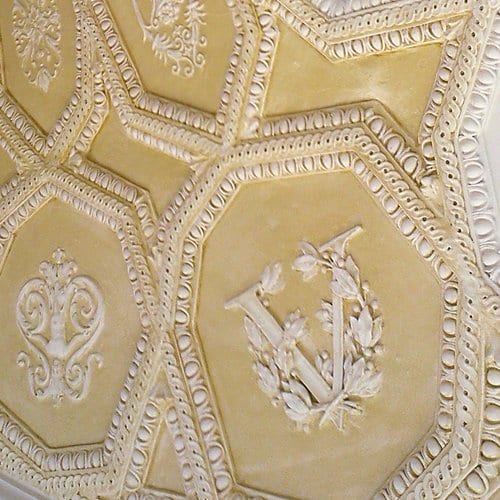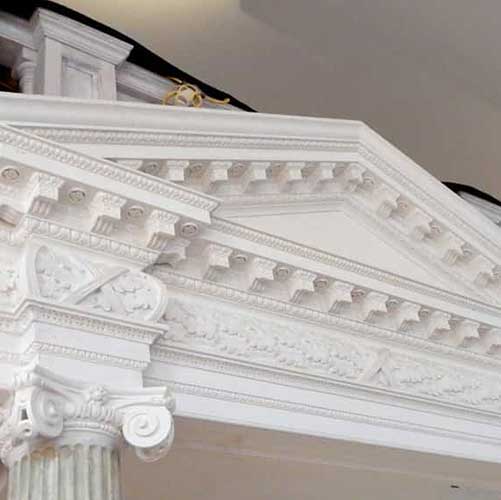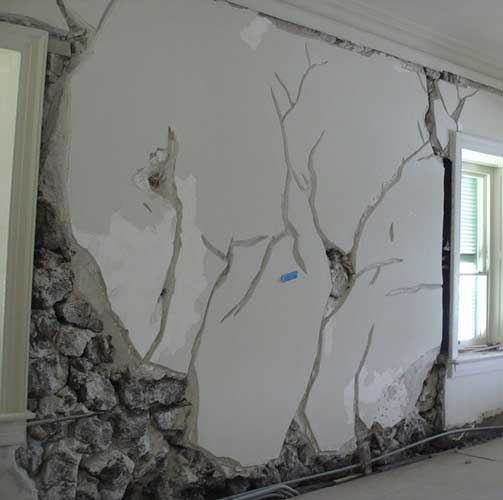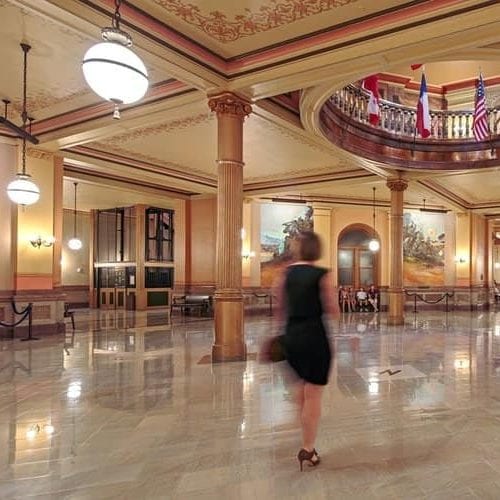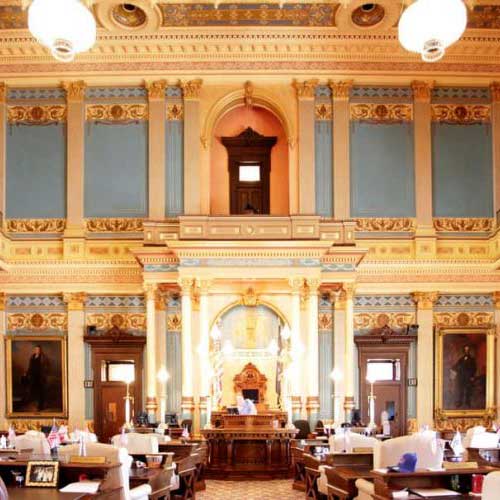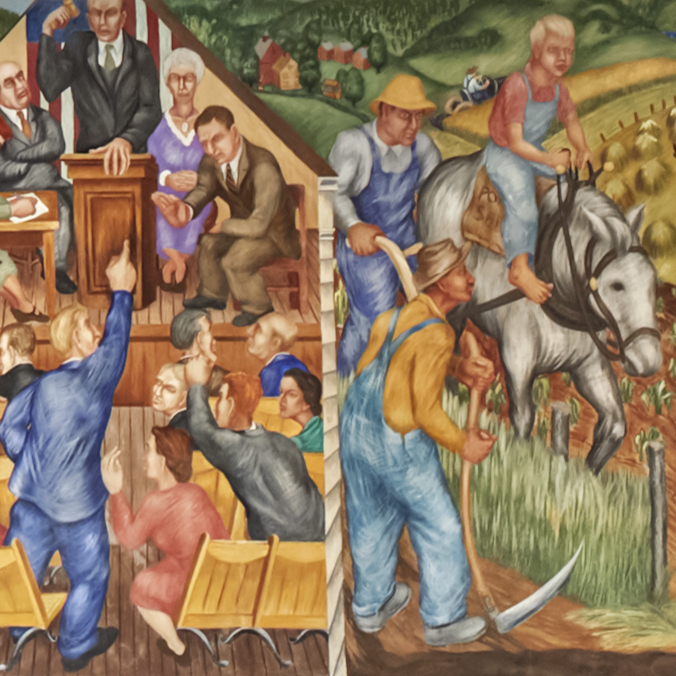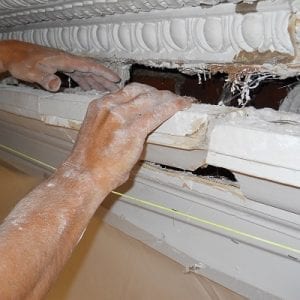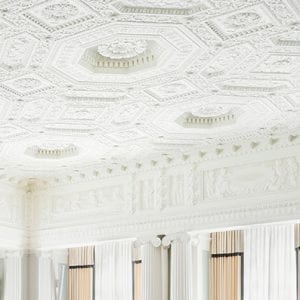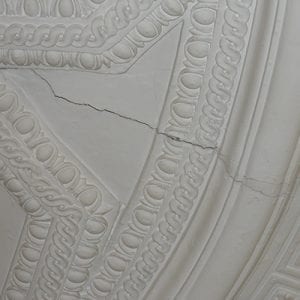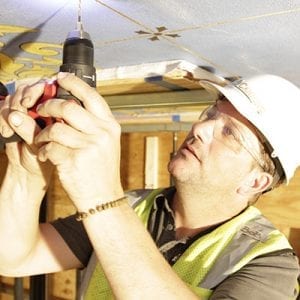Historic Plaster Restoration & Stabilization
Halt failure and return your historic, decorative plaster to its original beauty.
Plaster was commonly used in historic structures as both a construction medium as well as a form of ornamentation in the form of decorative mouldings, medallions, cornices, friezes, and other elements—often to stunning effect.
Unfortunately, it is not uncommon for historic plaster elements (both ornamental and flat) to crumble, crack, swell, broken keys, failing wood lath or otherwise fail with age. If you own or are working on a historic structure that includes failing historic plaster, restoring and stabilizing the original plaster is the first crucial step of the historic plaster restoration process to achieve lasting decorative paint and other finishes.
John Canning & Co.'s expertise in historic plaster restoration, stabilization, and replication is among the most respected in the industry. Our craftsmen do everything from traditional three-coat flat plaster and traditional lime plaster to the replication of delicate period elements. Just some of the techniques that our skilled artisans are adept at include running moulds, and ornamental fabrication, seamless acoustic plaster, integrally pigmented plaster, traditional plaster renders, scagliola plaster fabrication methods, and simulated effects such as ashlar block and textured plasters.
As plaster professionals, our work with historic and architectural plaster has evolved to include complex conservation and stabilization projects that other firms wouldn't even attempt. By applying our creative problem-solving methods to the demands of failing plaster substrates, we have arrived at innovative solutions to demanding problems.
Need an expert opinion for your project? Request a Consultation.
Our Plaster Restoration Process
The process of historic plaster restoration and stabilization varies from project to project based on a number of factors. That being said, the text below outlines generalized steps in our process.
Archival Research & Investigation
At the beginning of each engagement, our first aim is to understand the history of the structure so that we can ensure that our work will preserve and enhance the historic fabric of the building. This may involve conducting archival research to help us fill in the gaps, but this is not always necessary with plaster restorations.
Conduct Plaster Conditions Survey
We then seek to understand the conditions of the existing plaster and the underlying structure upon which it sits. The goal is twofold: First, to understand the cause of the original failure so that it can be addressed and resolved, in order to prevent future failure; second, to determine whether or not the underlying structure is sound enough to build upon or work with. It’s for this reason that many plaster restoration and stabilization projects begin with a plaster conditions survey.
Plaster Stabilization
After the cause of the failure has been identified and resolved, or sometimes beforehand, we stabilize the existing plaster. This may include reinforcement, consolidation, dismantling and reattachment, or patching as necessary.
Plaster Restoration
Once the existing plaster is stabilized and the risk of future failure is removed, the existing plaster will be restored as necessary, and recreated anywhere that gaps or damage exist.
We also believe in using the highest quality products made by some of the most dedicated people in the industry. This is why we are certified in HPCS products and are one of the few authorized HPCS installers.

Cost Analysis of a Historic Plaster Restoration
The exact cost of plaster restoration and stabilization naturally depends on a number of factors. These include, but are not limited to:
- Whether or not the process begins with a plaster conditions survey
- The size of the work
- The complexity of the work
- The location of the work, and required access (for example, whether or not scaffolding will be required to access the space)
- Special materials cost, such as consolidants, adhesives, etc.
For this reason, it is difficult to say what the “typical” cost for plaster restoration and stabilization may be. The surest way to get an accurate idea of what costs your project may entail is to contact us directly.
Our Specialties
In addition to plaster restoration and stabilization, we specialize in a number of other complementary services, including:
Selected Projects
See how John Canning Co. has restored original plaster in different historic buildings across the country.
We were involved in plaster stabilization and creating a new ceiling and beam structure independent of the severely compromised Garrett Hall building.
We skillfully restored the 1700s plaster walls and ornament in Maryland's Old Senate Chamber using the original historic methods and materials of the time.
Our company's expertise in plaster repair and restoration was essential for the successful restoration of Hulihe’e plaster-over-lava-rock construction.
John Canning & Co. performed flat and ornamental plaster restoration at the Kansas State Capitol, a US Historic National Landmark.
Our projects at Michigan Capitol 1989-92 and 2016 required expert woodgraining matching skills, and innovation in plaster reattachment and distemper paint conservation, and every other decorative painting skill.
Our fine-art conservation team stabilized and conserved two, wall-sized WPA murals at UNH. The murals suffered varying degrees of deterioration and loss due to moisture intrusion and plaster substrate destabilization over nearly 80 years.
Canning’s thorough knowledge of period decoration and methodology, as well as traditional materials, was a valuable contribution to the project team.
It has been my pleasure to work with the John Canning & Co. for over 15 years. Their talent and skill in execution is unique in the arena of historic restoration projects.
We have chosen to work with Canning almost exclusively on decorative conservation work for over twenty years in recognition of their overall abilities.

